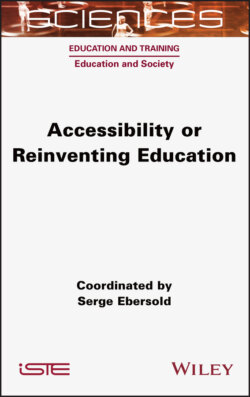Читать книгу Accessibility or Reinventing Education - Группа авторов - Страница 17
1.3. Accessibility, an imperative focused on the ergonomization of practices
ОглавлениеThis issue of singularization makes accessibility the means of responding to the challenges imposed by the growing presence of students who are out of step with the monitoring and learning standards produced by the school system (Beaud 2002). It aims to prevent the social vulnerabilities inherent in school failure and drop out by promoting an academic excellence that supports the weakest in acquiring a common base of knowledge and skills while encouraging the strongest to surpass themselves (OECD 1999; Thélot 2004). In contrast to the opposition that distinguishes the capable students from the incapable, this perspective prefers to distinguish the typical learner from the atypical one, whose incompleteness requires the mobilization of resources to support their potential in order to provide them with the resources needed to overcome, if necessary, the difficulties they face in fitting into their environment (Ebersold 2019). This is leading UNESCO’s International Standard Classification of Education (ISCED) to redefine the understanding of educational difficulties. Instead of the ineducability suggested by an essentialist vision of these difficulties, it suggests a developmental perspective relating them to a particular educational need, that may be more or less complex, which can be met through an accessibilization of the school environment targeting the singularity of individual dynamics in distinct approaches with an overarching aim (UNESCO 1997). This shift in perspective thus calls for priority attention to be given to learning processes and their contextualization in order to examine the conditions that enable vulnerable learners, such as those with an intellectual disability, to acquire skills in reading and arithmetic as well as social and emotional competencies (INSERM 2016).
The creation of school environments accessible to the greatest number and adapted to each individual is intended to enable all pupils to exercise their talents and develop their potential. Above and beyond the adaptation of practices to presupposed needs, it aims to develop the potential of learners by building the optimal learning environment required to enable them to engage actively in processes and adapt to changing contexts. It finds its protective character in the empowering effect of modes of pedagogical organization, that is, in the identity-related resources acquired by individuals to define themselves and become actors capable of authoring their futures (Rose and Meyer 2002). This empowering effect lies, for example, in the ability acquired by learners to seek, process and manage information flows, adapt to changing environments, be driven by a spirit of collaboration and mutual aid, and be autonomous in learning and open to the world (Bechetti-Guizot 2017; France Stratégie 2017). This empowering effect also lies in the academic success and social and professional enrollment of the students targeted by measures to combat school failure. Moreover, it consists of pedagogical organization methods concerned with the students’ proximal development area to enable them to develop their skills in an optimal manner. The development of diagnostic assessments for all pupils, which can be observed in many countries, is aimed at identifying the educational needs of learners at risk of failure at school, and the means and methods needed to meet them. In France, they are designed by the authorities as a tool for regulating learning and as an instrument of pedagogical adjustment, designed both to help pupils to learn and to guide teachers in their efforts to identify pupils in difficulty and/or at risk of failure at school. However, the accessibilization of school environments is framed by the articulation of three complementary approaches to accessibility detailed in Figure 1.1.
Figure 1.1. Approaches to accessibility across educational policies (adapted from Ebersold et al. 2019). For a color version of this figure, see www.iste.co.uk/ebersold/accessibility.zip
